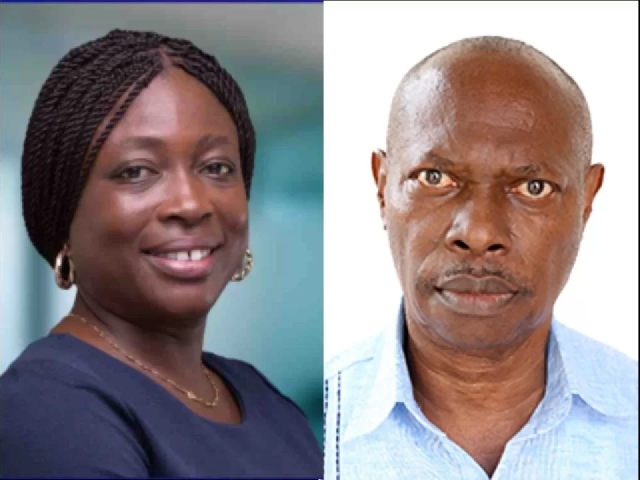GSA tested Lithovit fertiliser in ‘condom lab’ using ‘drinking water standards’; State exposed in COCOBOD trial
 Chief State Attorney Evelyn Keelson and the State's star witness Dr Yaw Adu-Ampomah
Chief State Attorney Evelyn Keelson and the State's star witness Dr Yaw Adu-Ampomah
It has emerged in the trial of the former COCOBOD boss and two others that not only was the test result on Lithovit liquid fertilizer tendered in evidence by the prosecution conducted in the wrong lab at the Ghana Standards Authority (GSA), but the wrong lab also used the specifications meant for a totally different product for its report.
The court heard that the Drugs, Cosmetics, and Forensic lab, which conducted the disputed test tendered by the prosecution as evidence of Lithovit liquid fertilizer's ineffectiveness, wrongly used specifications and ranges for testing water rather than those suitable for fertilizers.
It was, therefore, not surprising that the GSA test conducted by one Peter Quartey-Papafio in 2017 reached the conclusion that Lithovit “is harmful to humans, animals as well as hazardous to water.”
In an interesting twist, the third prosecution witness, Dr. Yaw Adu-Ampomah, whose petition to EOCO led to the test in question, had told the court that a board member of COCOBOD who happens to be a farmer informed him that Lithovit liquid fertilizer is like water that farmers drink on their farms when they are thirsty.
The former Chief Executive of COCOBOD, Dr. Stephen Opuni, businessman Seidu Agongo, and Agricult Ghana Limited, producers of Lithovit liquid fertilizer, have been facing 27 charges, including defrauding by false pretences, willfully causing financial loss to the state, corruption by public officers, and contravention of the Public Procurement Act in the purchase of Lithovit Liquid Fertilizer.
During the court proceedings, presided over by Justice Aboagye Tandoh, it was revealed that the Drugs, Cosmetics, and Forensic lab, which typically tests narcotics, pharmaceuticals, cosmetics, and medical devices including condoms, was not the appropriate lab for analyzing fertilizers.
Instead, the General Chemistry lab under the Material Science Department should have conducted the test.
This discrepancy has called into question the validity of the test result presented by the prosecution to demonstrate the ineffectiveness of Lithovit liquid fertilizer.
The prosecution has over the years relied heavily on the report from the wrong lab to prosecute their case, calling witnesses who also depended on this same report to discredit the efficacy of Lithovit liquid fertilizer.
These witnesses included former Deputy Chief Executive of COCOBOD, Dr. Yaw Adu-Ampomah, who the report was tendered through as part of his own committee report on Lithovit and admitted into evidence as Exhibit H.
But it has so far been proven in court that Dr. Adu-Ampomah was aware of another test result from GSA, conducted in the appropriate lab that confirmed that Lithovit was effective, having participated in a series of meetings at EOCO and in the office of former Senior Minister, Yaw Osafo Marfo, that discussed the conflicting reports.
Dr. Adu-Ampomah, however, conveniently excluded what is now believed to be the ideal test result from his report – that is Exhibit H.
Although Quartey-Papafio claimed in his report that he subcontracted part of the testing to the Material Science department, no evidence has been presented to confirm this.
The Head of Material Science Department of Ghana Standards Authority, Mrs. Genevieve Baah Mante, had told the court that she only got to know about the Quartey-Papafio report during a meeting at the Economic and Organized Crime Office (EOCO) that discussed the various reports.
On Tuesday, July 2, 2024, Ms. Fiona Gyamfi, a Chief Scientific Officer and a Laboratory Manager at the Water Laboratory at GSA, also denied knowledge of her department playing any role in the Quartey-Papafio’s report.
“Did you at the General Chemistry Laboratory ever get to know during all your discussions about the test that the forensic lab subcontracted the test resulting in the result in Exhibit H for testing? Did you get to know?” Mr Benson Nutsukpui asked the witness.
Madam Fiona Gyamfi, a subpoenaed witness for Mr. Agongo, responded, “No.”
“Did it come up at any time in your meetings in EOCO that Mr. Quartey-Papafio subcontracted the sample to another institution?” the witness was further asked, and her reply was “no.”
Madam Fiona Gyamfi testified in her evidence in chief led by Benson Nutsukpui, counsel for the second and third accused, that she was asked by EOCO to comment on the Quartey-Papafio report.
She stated that the results in the report were not adequate for her to make a remark, which she then included in her statement to EOCO.
When asked about the lab's inability to determine the suitability of the sample for cocoa growth, the witness explained that the GSA did not have a standard for cocoa fertilizer at the time of the test.
This was also documented in her statement to EOCO.
Furthermore, Gyamfi detailed the GSA’s subcontracting procedures, explaining that each lab has a specific scope of work.
If a lab lacks the capacity to perform a certain test, it can subcontract the work to another lab within the GSA. However, she reiterated that there was no record of the General Chemistry lab receiving any subcontracted sample for testing.
The court was shown that Mr. Quartey-Papafio’s report used GS175, a standard for water quality specifications for drinking water, rather than a standard for fertilizers.
Mr Gyamfi confirmed that GS175 is used exclusively for testing drinking water and has no references or standards applicable to fertilizers.
Moreover, the report’s findings on calcium, magnesium, and urea were based on GS175, which does not provide standards for these elements in the context of fertilizers.
Instead, such specifications are found in GS220 2014, which pertains to natural mineral water.
The witness affirmed that these standards could not be used to test fertilizers.
“Mr. Quartey-Papafio told the police that the remarks and recommendations were based on the result of the test and the standard used being that it did not conform with the specifications. Tell this Court, is it possible in science to rely on GS175 to determine whether the sample is good for cocoa?” counsel asked Madam Gyamfi, and her response remained, “no.”
The Quartey-Papafio’s report stated that the sample cannot be recommended for its intended purpose.
The witness was, therefore, asked, “How do you normally get the intended purpose of the sample?” “To determine that, usually a performance test must be done on the sample before you can determine its intended purpose,” Ms. Gyamfi answered.
“And then he was emphatic. ‘The sample, therefore, cannot be used as foliar nutrient on cocoa from nursery, growth and yield stage’. Look at the results stated in the table on page 106 of Exhibit H. Can that lead to the conclusion reached by Mr. Quartey-Papafio?” the witness was asked.
She replied, “No because with the specifications, if you look at our standards it should come either in maximum or minimum before we can say that the results are within or not within the specification.”
Madam Gyamfi also maintained that the GSA standards cannot be used to determine whether a product can be used as foliar nutrient from nursery, growth and yield stage.
The six-year trial continues to expose significant procedural flaws and misuse of standards in the prosecution's case against the accused persons.
Find below excerpts of Tuesday’s proceedings:
Q: Yesterday we ended up on the statement you gave at EOCO and I was asking if there was any discussion with EOCO on the Quartey-Papafio report.
A: Yes.
Q: What was the discussion?
A: I remember when we were about to leave, I was finally asked that if I should give remarks on that report what would I say?
Q: And what did you say?
A: And then I said the result stated in the report is not adequate enough for me to make a remark.
Q: So when you said that what did they say?
A: They said it's fine; it’s okay.
Q: In relation to your statement what did they do?
A: They asked me to write it so I stated it in my statement.
Q: And with respect to cocoa, what did you tell them and what did they ask you to do?
A: Because in their request they wanted us to also find out if the sample was suitable for cocoa growth and we could not determine that, they asked us why and then I responded that we did not have a standard for cocoa fertilizer at the time of the work that was why we could not do it.
Q: So your response on that, what did they ask you to do?
A: We were asked to also write it in our statement.
Q: And did you?
A: Yes.
Q: When you say we, who and you went to EOCO?
A: My HOD and myself.
Q: Was there any other meeting in respect of this test between your department and any other person or institution that you know about?
A: Yes. We received an invitation to meet with Honourable Osafo Marfo.
Q: Did you know his designation at the time?
A: He was a Senior Minister by then.
Q: And when you say we received an invitation. Who received the invitation?
A: Mrs. Genevieve Baah Mantey and myself.
Q: In respect of what?
A: The analysis we conducted on the samples.
Q: Did the meeting come on?
A: Yes.
Q: You personally, were you at that meeting?
A: No.
Q: Why were you not at the meeting?
A: When the invitation came, the time for the meeting was 5 pm and at that time my nanny had travelled so I had to go and pick my children from school myself so I could not make it to the meeting.
Q: But do you know whether the meeting came on anyway although you were not there?
A: Yes my HOD told me.
Q: You talked about you sub-contracting a test to the forensic lab. That is a very normal procedure with Ghana Standard Authority. Is that the case?
A: Yes.
Q: How is it done?
A: Because of the nature of our work, every laboratory has its scope of work so if you receive a sample and you cannot analyse or the lab does not have the capacity to do a particular parameter or test, the authority allow us to give it to any of our sister labs.
Q: And what is the procedure?
A: We have the sub-contracting form so you fill it with the sample particulars together with the parameter or the test you want to carry out then you send the sample together with the sub-contract form you fill to the lab you are sub-contracting to. Then the lab will also take it, fill part of the form and then return a copy back to you. Then they will tell you when you can come for the result or when the result would be read. The lab can pick it by itself or would be sent to the secretary for dispatch to the lab.
Q: Are those sub-contracts entered into your books?
A: When you are sending the sample you don’t enter but when you receive the sample you enter.
Q: So the General Chemistry lab would enter it when they receive it?
A: Yes.
Q: Tell this Court. Do you have a Material Science Department?
A: Yes
Q: The Material Science Department, what do they do?
A: It is a department that houses the six various laboratories under it.
Q: So when somebody says that they sub-contracted the sample to the Material Science laboratory, in your institution, Ghana Standard Authority, what would that mean?
A: It could be one of the labs under the department.
Q: Have you seen Exhibit H page 105 where Quartey-Papafio’s result is? Look at the next page where the results are. Mr. Quartey-Papafio’s test relies on some standard; he quoted a standard at the specification column.
A: GS175 part 1.
Q: You have a copy of GS175 part 1?
A: Yes.
Q: What document is the GS175?
A: Water quality specification for drinking water.
Q: At Ghana Standard Authority, what do you use GS175 for?
A: It is used at the water laboratory for testing drinking water.
Q: Look at the photocopy I gave you. Is that photocopy an extract, of the cover page, foreword and pages 1 to 7 of GS175?
A: Yes.
COUNSEL FOR 2ND AND 3RD ACCUSED: We wish to tender it through her.
COUNSEL FOR REPUBLIC: We don’t have an objection.
COUNSEL FOR 1ST ACCUSED: We don’t have an objection and we wish to add that as contained in Exhibit H with the Ghana Standard Authority report by Quartey Papafio, it states that the specification is GS175 and that is the document we have.
BY COURT: The extract, Ghana Standard GS175:.2017, 5th Edition (Water Quality – Specification for drinking water is tendered without an objection from counsel for A1 and the Prosecution and same is admitted and marked as Exhibit 147/A2 and A3.
Q: Tell this Court, look through the GS175, the copy you have and the extract Exhibit 147 and tell this Court if there is any standard or reference for fertilizer.
A: There is none.
Q: Can GS175, Exhibit 147 be the standard for testing fertilizer?
A: No.
Q: You have Exhibit H page 106 where the results are. You would find the entry there; calcium and the specification for calcium is 19.7. Have you seen it?
A: Yes.
Q: Is there any range, standard or reference for calcium in GS175 Exhibit 147?
A: No.
Q: What about magnesium, is there any range, reference or standard in Exhibit 147, GS175?
A: No.
Q: Is the reference, standard or range for urea in Exhibit 147?
A: No.
Q: Mr. Quartey-Papafio told the Ghana Police that he sub-contracted the Exhibit to the Material Science Laboratory. Would you know the laboratory where he sub-contracted to?
A: No.
Q: Did you at General Chemistry Laboratory ever get to know during all your discussions about the test that forensic lab sub-contracted the test resulting in the result in Exhibit H for testing? Did you get to know?
A: No.
Q: Did it come up at any time in your meetings in EOCO that Mr. Quartey- Papafio sub-contracted the sample to another institution?
A: No.
Q: If you look at the same Exhibit H page 106, it talks about calcium, magnesium and urea. If you want the reference for calcium and magnesium, where would you find it?
A: It would be found in the GS220 2014. That is water quality specification for natural mineral water.
Q: What do you have in your hand?
A: An extract of the GS220 2014.
Q: There is a table in the GS2014 itself where the specifications are. Is that correct?
A: Yes.
Q: Mr. Quartey-Papafio told the police that the remarks and recommendations were based on the result of the test and the standard used being that it did not conform with the specifications. Tell this Court, it is possible in science to rely on GS175 to determine whether the sample is good for cocoa.
A: No.
Q: Go back to page 106 of Exhibit H. Mr. Quartey-Papafio was very detailed in his remark. He said “from the foregoing examination and testing, the sample has been adulterated and does not meet the specifications of the standard”. Can you from looking at his report state which standard he based his testing and analysis on?
A: I believe he was talking about the GS175 part 1.
Q: He went on interestingly to state that the sample is not recommended for its intended purpose. How do you normally get the intended purpose of the sample?
A: To determine that, usually a performance test must be done on the sample before you can determine its intended purpose.
Q: And then he was emphatic. “The sample, therefore, cannot be used as foliar nutrient on cocoa from nursery, growth and yield stage”. Look at the results stated in the table on page 106 of Exhibit H. Can that lead to the conclusion reached by Mr. Quartey-Papafio?
A: No because with the specifications, if you look at our standards it should come either in maximum or minimum before we can say that the results are within or not within the specification.
Q: Can you, using your standards at Ghana Standard Authority to see whether a product can be used as foliar nutrient from nursery, growth and yield stage.
A: No.
Q: Can this table on page 106 of Exhibit H truly form the basis of the conclusion that “it is harmful to humans, animals as well as hazardous to water?
A: No.
Q: You have in your hand a photocopy of the GS220. That is correct?
A: Yes.
Q: You told this Court that that is where you can get the range of calcium and magnesium. On which page is the table?
A: Page 5.
COUNSEL FOR 2ND AND 3RD ACCUSED: We wish to tender it through her.
COUNSEL FOR REPUBLIC: I have no objection.
COUNSEL FOR 1ST ACCUSED: I don’t’ have any objection.
BY COURT: A photocopy of the Ghana Standard GS220:2014 5th Edition (Water Quality –Specification for Natural Mineral Water) is tendered without objection from Counsel for A1 and the Prosecution and same is admitted and marked as Exhibit 148/A2 and A3.
Q: Open page 5 of Exhibit 148; table 2 under the heading physical and macro constituent. What is the first item under characteristic, pH value?
A: It is the acidity or the basicity. How acidic or basic a substance is.
Q: Is that the test you do for fertilizer?
A: No.
Q: So when Mr. Quartey-Papafio based his conclusion on the fact that the pH value is 9.3 in Exhibit H page 106, he definitely was not testing for fertilizer. Was he?
A: I don’t know if it was part of the request EOCO made when they submitted the sample to him.
Q: But what I want to find out is this. Would you need to test for pH value when you are testing fertilizer?
A: At the time of the work there was no Ghana Standard for fertilizer so I don’t know why Mr. Quartey-Papafio tested for it.
Q: Did you as the laboratory manager test for pH value when you are testing for fertilizer?
A: We normally do not test for pH value.
Q: In 2017, did you had any standard for urea?
A: No.
Q: So the reference for urea in Mr. Quartey-Papafio’s report, Exhibit H page 106 was not available amongst the GSA standards in 2017. Was it?
A: At that time there was no standard.
CROSS EXAMINATION OF DW6/A2 AND A3 BY COUNSEL FOR A1.
Q: Look at Exhibit 147. It is the present existing Ghana Standard Authority standards on drinking water?
A: Yes.
Q: And this is what is referred to by Mr. Quartey-Papafio as the specification he used in the first Ghana Standard Authority report contained in Exhibit H.
A: Yes.
Q: Until 2017, the previous standards on drinking water was GS175/2013. Is that not so?
A: That is so.
Q: What the Ghana Standard Authority does is that it keeps on improving upon standards by bringing on board international standards to an already existing standard in order to bring it up to best practice existing at the time. Is that not so?
A: No. What is done is, the standards are reviewed between 4 and 5 years so based on situations to improve them.
Q: You would agree with me that when the reviews are done, they are done to improve the existing standards. Is that not so?
A: Yes.
Q: All these standards with respect to GS175 concerns standards for drinking water. Is that not so?
A: It is.
Q: In fact, when it comes to the scope of drinking water, you have a standard for a package bottle drinking water which is different from package bottled natural water.
A: Yes.
Q: When it comes to even the committee which agrees or works on the standards, you have various governmental bodies and representatives from the Ghana Research Institute, the chemistry department of the university of Ghana together with other persons and officials from the Ghana Standard Authority. These constitutes the technical committee members on water quality. Is that not so?
A: Yes.
Q: In 2017, when this standards i.e. GS175 2017 was published, it was as a result of an agreement by this committee on drinking water standards.
A: Yes.
Q: Can you tell us the standards for packaged natural mineral water?
A: That is the GS220 2014.
Q: So that is Exhibit 148. Is that not the case?
A: Yes.
Q: In 2017, when your committee reviewed the standards for packaged and bottled drinking water, you had a different committee also for natural mineral water.
A: At that time, in 2017, the GS220 2014 was already available.
Q: But you had a technical committee for this natural mineral water which is different from the drinking water.
A: Yes.
Q: The technical committee of which you were a member, they took into consideration 40 references in coming to the specification for drinking water.
A: If that is what is here then yes.
Q: In agreeing on the standards for drinking water, the technical committee undertook some technical evaluation including identifying different kind of definitions for water for purposes of standards.
A: Yes.
Q: In terms of water by way of standardisation under 175 we have different types of it include packaged bottled water, prepared water, spring water, water defined by origin. That is it?
A: Yes?
Q: When it comes to water defined by origin, you look at water which comes from underground or from the surface of water. Is that not it?
A: Yes.
Q: Then when it comes to natural mineral water, you are dealing with micro biologically wholesome water which originates in an underground water table or deposit. Is that not it?
A: Yes.
Q: All these different kinds of water as contained in Exhibit 147, GS175 is important for purposes for standardisation.
A: Yes.
Q: Turn to page 5 of Exhibit 147. It is a very basic thing that you also have prepared water and under prepared water, this is water that do not comply with the provisions of water under section 4 of this Exhibit 147.
A: Yes.
Q: As a scientist in GSA and the lab, even if you are not in the water laboratory, some of these standards particulars of which are contained in this Exhibit 147 would definitely be known to the scientists in the laboratory.
A: No.
Q: If they don’ t know because it is not their speciality, once they are required to do a test and they state and or referenced it in their test as a standard, that person would definitely have seen it. Do you agree?
A: I don’t agree.
Q: I am putting it to you that it is not possible for somebody who is testing for a substance in a lab and using Exhibit 147 as a standard not to make reference and or take into considerations the standards contained in Exhibit 147 before coming out with a report.
A: It is possible you have not seen it before. What we normally do is, if the lab is not your lab and the sample has been sub-contracted to you, you are supposed to attach that report to your report; you don’t lift the figures from the sub-contracted test report and report as if you worked on it.
Q: If you are not in the water lab and you have a sample of any substance and you state in your report that you are testing the sample against the standards of water then it is a necessary requirement that you have to take into consideration the standards for water before coming out with your report. Is that not it?
A: Yes. For instances like what we are going through, it is important for the person reporting to be sure of what he or she is putting in the report.
Q: In testing for the chemical requirement of what would constitute or what is a standard water, you are required as contained in page 6 of Exhibit 147 you are required to consider 15 chemical requirement which are listed there.
A: Yes.
Q: When you consider any substance against the standard, if you don’t get these 15 chemical requirements then the water cannot be said to have passed the standards of what is good water in Ghana.
A: No, because it is not only these parameters we base on to say that water is wholesome but there are others.
Q: But with respect to drinking water, these are the chemical requirement.
A: Yes.
Q: You also have a different standards for agricultural water i.e. water for irrigation. Do you?
A: I have not seen any.
Q: When it comes to standardization and when you talk about drinking water as it is contained in Exhibit 147 and specifically page 1 with respect to the scope, you can only refer to drinking water for human beings as this is the definition contained herein.
A: I believe so.
Q: You would also agree that all personnel in the various laboratories of the Ghana Standard Authority are not oblivious to the fact that their work relates to specialized testing of standards of particular products.
A: Everybody there is specialized to his or her lab or scope.
Q: It is due to this level of specialization that Ghana Standard Authority as a protocol where a particular lab will sub-contract a particular testing or a part of it because it is not in its area of expertise with respect to maybe an aspect of it.
A: Yes. There are a number of reasons why we do sub-contracting. An example could be 1. Specialization 2. Equipment etc.
Q: Even when a sample and in this case water is submitted for testing by the chemistry laboratory, the aspect on toxicology would be sub-contracted to another lab in the GSA because of the expertise. Is that not so?
A: Yes.
Q: Where is Mr. Quartey-Papafio now? Is he on pension?
A: Yes he is on retirement.
Q: When did he go on retirement?
A: I cannot remember.
Q: You would agree with me that because of the level of specialization by way of testing of products at the GSA, all the lab technicians, yourself inclusive are aware of their area of specialization.
A: Yes.
Q: You would also agree with me that the forensic, drugs and cosmetic department is a different department from the Material Science Department which has control over the chemistry lab.
A: Yes.
Q: So that can any agency, EOCO inclusive decide to send a sample to any department for testing?
A: Yes, because they might not know where exactly to take it to.
Q: In the course of your work at the Ghana Standard Authority, have you had an instance where a sample had been brought to your department which should have been send to another department for testing?
A: A lot.
Q: When it happens what do you do?
A: When we notice that the sample had already been received mistakenly, we will quickly call the client because we take their contact and advise the client on which laboratory is specialised to do that analysis and then a new contract would be signed but in instances that the client is not reachable, we will take it to the right lab as a sub-contracted work and then we pick the report on behalf of the client and give it to the client.
Q: In respect to the first Ghana Standard Authority report, I will refer to Mr. Quartey-Papafio’s report which is contained in pages 106 of Exhibit H. You can confirm that the forensic science laboratory is not the proper department to conduct a test on fertilizer.
A: Looking at their scope of work, fertilizers do not fall within. So they are not the right people to do the analysis.
Q: By the normal procedure of Ghana Standard Authority as you have outlined, what should have happened was that EOCO should have been called back to take the sample to the chemistry lab or if EOCO could not be reached, the forensic science laboratory should on its own have sub-contracted the chemistry lab to do the analysis. Is that not it?
A: Yes.
Q: Have you had instances where the clients or the customer has insisted that a particular laboratory should conduct the test even when its attention has been drawn to this fact i.e. that it is not the competent laboratory to conduct the test?
A: I have not experienced any such situation before.
Q: But in your stay or in your duties as a staff of GSA you had few instances but at least some in which the reports of the GSA has been challenged by an opposing party.
A: Yes.
Q: This happens because either the sample for testing which was brought to GSA was not well handled and therefore a wrong results was obtained. Is that not it?
A: No. The contentions are not usually with how we handle the samples. It is usually when the samples are not fulfilling requirements because for GSA a number of measures are taken before tests are carried out including how the samples are even handled and then also for us to issue a report that a sample is failing, a number of tests would have been done before.
Source: classfmonline.com
Trending News

Ghana Gas refutes shutdown claims, confirms Atuabo plant back in operation
12:47
Instead of focusing your guns on me, focus on holding the government accountable – Bawumia to other NPP flagbearer aspirants
12:21
C40 endorses AMA's energy efficiency campaign as model for Global Climate Action
12:18
First human case of flesh-eating screwworm parasite confirmed in US
01:13
NDC Spain Branch condemns attack on nurses
17:10
Fisheries Minister inaugurates committee to develop curriculum for Anomabo Fisheries College
12:35
NDC does not intend to fulfil their lofty promises to Ghanaians – Bawumia
01:48
YEA graduates 795 Community Protection Assistants in Volta, Eastern, Oti regions
14:15
Defence Ministry inaugurates board to probe Z-9 helicopter crash
16:07
W/R: NAIMOS conducts joint anti-galamsey operation with Blue Water Guard on Ankobra river
19:18



